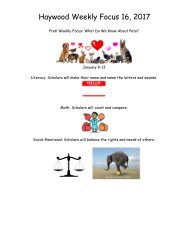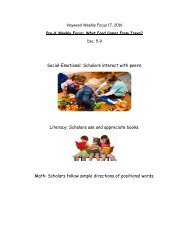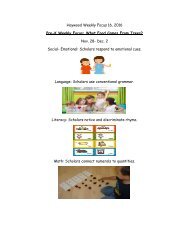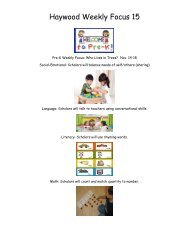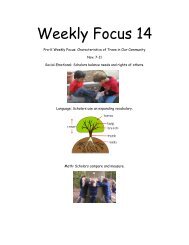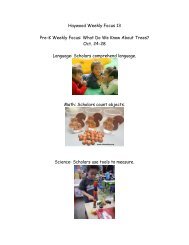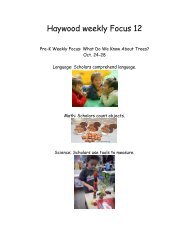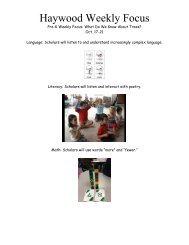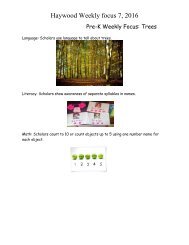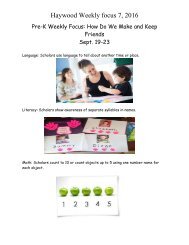Weekly Focus 17 2017
Create successful ePaper yourself
Turn your PDF publications into a flip-book with our unique Google optimized e-Paper software.
Haywood <strong>Weekly</strong> <strong>Focus</strong> <strong>17</strong>, 20<strong>17</strong><br />
Jan. <strong>17</strong>-20<br />
PreK <strong>Weekly</strong> <strong>Focus</strong>: What Do We Know About Pets?<br />
Literacy: Scholars identify and name letters in names.<br />
Math: Scholars count and sort items.<br />
Physical: Scholars use scissors to cut pet pictures.
Haywood <strong>Weekly</strong> <strong>Focus</strong> <strong>17</strong>, 20<strong>17</strong><br />
Subject<br />
RLA<br />
Scholars will identify supporting details.<br />
Kindergarten <strong>Weekly</strong> <strong>Focus</strong><br />
Scholars will write about real people, animals, places and events with details.<br />
RI.K8 With prompting and support, identify the reasons an author gives to support points<br />
in a text.<br />
W.K.2 Use a combination of drawing, dictating, and writing to compose<br />
informative/explanatory texts in which they name what they are writing about and<br />
supply some information about the topic.<br />
Activities for home: Read to your student about animals, people, or special events, practice<br />
writing simple sentences about things that are important to your family.
Haywood <strong>Weekly</strong> <strong>Focus</strong> <strong>17</strong>, 20<strong>17</strong><br />
Math Scholars will count out objects up to 15.<br />
K.CC.B.5 Count to answer “how many?” questions about as many as 15 things arranged in<br />
a line, a rectangular array, or a circle, or as many as 10 things in a scattered<br />
configuration; given a number from 1-15, count out that many objects.<br />
Activities for home: Practice counting items around your home: pennies, plates, pieces of<br />
cereal, etc. in varying amounts.<br />
Social<br />
Studies<br />
Scholars will research and describe an important national holiday.<br />
K.29 Participate in shared research projects to identify and describe the<br />
events or people celebrated during state and national holidays and why we<br />
celebrate them: Martin Luther King, Jr.<br />
Activities for home: Have conversations about important state and national holidays and<br />
leaders, both in the United States and other countries.<br />
Science<br />
Our scholars will spend this week focusing on social studies.
Haywood <strong>Weekly</strong> <strong>Focus</strong> <strong>17</strong>, 20<strong>17</strong><br />
Language Arts:<br />
**Standard:<br />
RF.1.3c Know final _e and common long<br />
vowel team conventions for representing<br />
long vowel sounds.<br />
Objective:<br />
I can read and write long i words with a<br />
silent e.<br />
**Standard:<br />
RI.1.5 Know and use various text features<br />
(e.g. headings, tables of contents,<br />
glossaries, electronic menus, icons) to<br />
locate key facts or information in a text.<br />
Objective:<br />
I can identify text features and explain the<br />
reason the author included them by using<br />
a sentence frame: The author included<br />
____(text feature) to show<br />
_________________.<br />
Standard:<br />
RI1.3 Describe the connection between<br />
two individuals, events, ideas, or pieces of<br />
information in a text.<br />
Objective:<br />
I can compare and contrast to understand<br />
a selection better.<br />
**Standard:<br />
W 1.1 Write opinion pieces in which they<br />
introduce the topic or name the book they<br />
are writing about, state an opinion, supply<br />
a reason for the opinion, and provide<br />
some sense of closure.<br />
Objective:<br />
I can write my opinion about a topic and<br />
give reasons for my opinion in complete<br />
sentences.<br />
Journeys Lesson 15:<br />
Informational Text: Animal Groups<br />
Genre: Informative<br />
Strategy: Monitor/Clarify<br />
Skill: Compare/Contrast,<br />
Text and Graphic Features<br />
Fluency: Intonation<br />
Vocabulary: Suffixes –er, -est<br />
Writing: Opinion<br />
Grammar: The Verb be<br />
High Frequency Words/Sight Words:<br />
bird, fly, those, both, long, walk, eyes, or<br />
Word Study/Spelling Words:<br />
time, bike, like, white, kite, drive
Haywood <strong>Weekly</strong> <strong>Focus</strong> <strong>17</strong>, 20<strong>17</strong><br />
Mathematics:<br />
*Tuesday 1/<strong>17</strong>/<strong>17</strong><br />
Standard: 1.OA.C.6 Add and subtract within 20, demonstrating<br />
fluency for addition and subtraction within 10. Use strategies<br />
such as counting on; making ten (e.g., 8 + 6 = 8 + 2 + 4 = 10 + 4 =<br />
14); decomposing a number leading to a ten (e.g., 13 – 4 = 13 –<br />
3 – 1 = 10 – 1 = 9); using the relationship between addition and<br />
subtraction (e.g., knowing that 8 + 4 = 12, one knows 12 – 8 =<br />
4); and creating equivalent but easier or known sums (e.g.,<br />
adding 6 + 7 by creating the known equivalent 6 + 6 + 1 = 12 + 1<br />
= 13).<br />
Objective: I can use numbers to show how<br />
to use a make ten strategy ten to add.<br />
Go Math 3.9 Use Make a Ten to Add<br />
*Wednesday 1/18/<strong>17</strong><br />
Standard: 1.OA.B.3 Apply properties of<br />
operations as strategies to add and<br />
subtract.<br />
Objective: I can use the associative<br />
property of addition to add three addends.<br />
Go Math 3.10 Add Three Numbers<br />
*Thursday 1/19/<strong>17</strong><br />
Standard: 1.OA.B.3 Apply properties of<br />
operations as strategies to add and<br />
subtract.<br />
Objective: I can understand and apply the<br />
Associative Property or Commutative<br />
Property of Addition to add three<br />
addends.<br />
Go Math 3.11 Add Three Numbers<br />
*Friday 1/20/<strong>17</strong><br />
Standard: 1.OA.A.2 Solve word problems<br />
that call for addition of three whole<br />
numbers whose sum is less than or equal to 20, e.g., by<br />
using objects,<br />
drawings, and equations with a symbol for the unknown<br />
number to represent the<br />
problem.<br />
Objective: I can solve adding to and<br />
putting together situations<br />
using the strategy draw a picture.<br />
Go Math 3.12 Use Addition Strategies<br />
Make a Ten Strategy<br />
Make a Ten Strategy
Haywood <strong>Weekly</strong> <strong>Focus</strong> <strong>17</strong>, 20<strong>17</strong><br />
Science:<br />
GLE.0107.9.1<br />
**Standard: Classify objects<br />
according to their physical<br />
properties.<br />
GLE 0107.9.2<br />
**Standard: Distinguish between<br />
the properties and solids and<br />
liquids.<br />
Objective: I can classify and<br />
compare and contrast solids and<br />
liquids by using a Venn Diagram<br />
based on their size, shape, color,<br />
flow, ability to attract magnets, and<br />
appearance when mixed.
Haywood <strong>Weekly</strong> <strong>Focus</strong> <strong>17</strong>, 20<strong>17</strong><br />
Social Studies:<br />
Unit 4: Our Country the United States<br />
Standard:<br />
History:<br />
1.39 Use informational text to help<br />
describe the importance of celebrating<br />
these national holidays such as Martin<br />
Luther King Jr. Day.<br />
Objective:<br />
I can describe the importance of<br />
celebrating Martin Luther King Jr Day by<br />
listening to a biography, talking with a<br />
partner and using the sentence frame:<br />
We celebrate Martin Luther King Jr. Day,<br />
because he led a movement for African<br />
American people to have equal rights.<br />
Martin Luther King helped people to have<br />
equal rights by ____________(action).<br />
Standard:<br />
Culture:<br />
1.2 Define multiculturalism as many<br />
different cultures living within a<br />
community, state, or nation.<br />
Objective:<br />
I can connect my study of Martin Luther<br />
King’s life with multiculturalism by<br />
recognizing that he promoted the idea<br />
that all people and cultures should be<br />
treated fairly and equally.<br />
The Story of Martin Luther King Jr. by “Kid President”<br />
https://www.youtube.com/watch?<br />
v=4xXZhXTFWnE
Haywood <strong>Weekly</strong> <strong>Focus</strong> <strong>17</strong>, 20<strong>17</strong><br />
Second Grade <strong>Weekly</strong> <strong>Focus</strong><br />
Essential Question: Why is it important to keep trying even if<br />
something is difficult to do?
Haywood <strong>Weekly</strong> <strong>Focus</strong> <strong>17</strong>, 20<strong>17</strong><br />
Phonics<br />
Long I (i, igh, ie, y)<br />
Final syllable le<br />
Topic Standards I Can…<br />
RF.2.3a distinguish long and<br />
short vowels when reading onesyllable<br />
words.<br />
RF.2.3b know spelling-sound<br />
correspondences for vowel<br />
teams.<br />
RF.2.3c decode two-syllable<br />
words with long vowels.<br />
Strategies:<br />
Sight word review<br />
-Picture sorts<br />
-Making words<br />
-Sound boxes<br />
-Analogy chart<br />
-chunk big words<br />
-high frequency<br />
-Word cards<br />
-Decodable reader<br />
-Model fluency<br />
Connect sounds to writing and<br />
dictate sentences.<br />
Vocabulary<br />
I can acquire and use new vocabulary<br />
words.<br />
The crowd cheered for Jackie<br />
Robinson.
Haywood <strong>Weekly</strong> <strong>Focus</strong> <strong>17</strong>, 20<strong>17</strong><br />
Comprehension<br />
Main Idea and Details<br />
Target Skill: Sequence of Events<br />
Formal and Informal Language<br />
Vizualization<br />
Supplemental Literature:<br />
My Brother Martin by Christine King<br />
Farris<br />
Teammates by Peter Golenbock<br />
Baseball Saved Us by Ken<br />
Monchizuki<br />
Moses: When Harriet Tubman Led Her<br />
People to Freedom by Carole Boston<br />
Weatherford<br />
Henry’s Freedom Box: A True Story<br />
From the Underground Railroad by<br />
Ellen Levine<br />
Sit In: How Four Stood Up by Sitting<br />
Down by Jane Addams<br />
The Drinking Gourd (Essential Lit-<br />
Dismukes)<br />
Biblioburro: A True Story from<br />
Columbia by Janette Winter<br />
The Fantastic Undersea Life of<br />
Jacques Cousteau<br />
Martin’s Big Words by Doreen<br />
Rappaport<br />
Harvesting Hope: The Story of Ceasar<br />
Chavez by Kathleen Krull<br />
The Story of Ruby Bridges by Robert<br />
Coles<br />
The Librarian of Basra: A True Story<br />
from Iraq by Janette Winter<br />
Bringing the Rain to Kapiti Plain by<br />
Verna Aardema<br />
A Story A Story by Gail E. Haley<br />
RL.2.2 Recount stories and<br />
determine their message,<br />
lesson, or moral.<br />
RL.2.10 Read and comprehend<br />
literature.<br />
I can identify the order of events<br />
in a story.<br />
I can retell what happened in a<br />
story by telling the order in which<br />
things happen.
Haywood <strong>Weekly</strong> <strong>Focus</strong> <strong>17</strong>, 20<strong>17</strong><br />
Strategies:<br />
-Five finger retell<br />
-Recall info. (BME)<br />
-Retell events in sequence<br />
-Discuss character’s feelings
Haywood <strong>Weekly</strong> <strong>Focus</strong> <strong>17</strong>, 20<strong>17</strong><br />
Grammar<br />
L.2.1 Demonstrate command of<br />
the conventions of standard<br />
English grammar and usage<br />
when writing or speaking.<br />
I Can...<br />
determine if nouns are singular or<br />
plural to identify subject-verb<br />
agreement.<br />
Writing:<br />
Opinion Writing<br />
W.2.1 Write opinion pieces in<br />
which they introduce the topic<br />
or book they are writing about,<br />
state an opinion, supply reasons<br />
that support the opinion, using<br />
linking words (i.e because, and,<br />
also) to connect opinion and<br />
reasons, and provide a<br />
concluding statement or section.<br />
I can identify an opinion about the<br />
text or topic.<br />
I can produce and identify at least<br />
two supporting reasons for the<br />
opinion.
Haywood <strong>Weekly</strong> <strong>Focus</strong> <strong>17</strong>, 20<strong>17</strong><br />
Math:<br />
2.MD.A.2- Measure the length of<br />
an object twice, using length<br />
units for two measurements…
Haywood <strong>Weekly</strong> <strong>Focus</strong> <strong>17</strong>, 20<strong>17</strong><br />
Social Studies:<br />
Unit 5: Famous Americans<br />
2.32<br />
Participate in shared research using<br />
biographies to interpret the<br />
significance of contributions made<br />
by people of the United States,<br />
recounting or describing key ideas<br />
and details from the texts. Teachers<br />
may choose any biographies.<br />
2.33<br />
With guidance and support from<br />
adults, use a variety of digital tools<br />
to produce and publish a writing<br />
piece in collaboration with peers on<br />
a famous American to describe how<br />
his or her accomplishments were<br />
significant.<br />
2.39<br />
Summarize the importance of<br />
commemorative months including<br />
Black History, Women’s History,<br />
Hispanic Heritage, and American<br />
Indian Heritage.<br />
<strong>Weekly</strong> Reader: Week 16<br />
I can research a Famous American in<br />
the United States and share their<br />
contributions with the class.<br />
Websites<br />
www.kidinfo.com<br />
www.brainpopjr.com<br />
kids.usa.gov/socialsocialstudiesforkids<br />
.com<br />
www.pebblego.com<br />
Resources:<br />
Journeys Anchor Text:<br />
Helen Keller (T314)<br />
Informational Text:<br />
Jackie Robinson (T164)<br />
Read Aloud: Doctor Salk’s Treasure<br />
(T214)<br />
Informational Text: Heroes Then and<br />
Now (T464)<br />
Read Aloud: Steve Jobs: Inventor<br />
(T410)
Haywood <strong>Weekly</strong> <strong>Focus</strong> <strong>17</strong>, 20<strong>17</strong><br />
3 rd Grade <strong>Weekly</strong> <strong>Focus</strong><br />
Subject<br />
ELA<br />
<strong>Weekly</strong> Skills to Practice<br />
For the next 2 weeks, 3 rd grade ELA students will be focusing on MAKING<br />
CONNECTIONS and then being able to combine it with the skill of SYNTHESIZING in<br />
weeks to come. Those connections will first be broken down into students being<br />
able to apply it in 3 different ways: TEXT TO SELF, TEXT TO TEXT and TEXT TO<br />
WORLD. Next, student will be able to avoid making surface connections, and use<br />
higher order thinking skills to making deeper connections to a given text.<br />
Comprehension Skill/Strategy: Summarizing, Determining Importance, and Main Idea
Haywood <strong>Weekly</strong> <strong>Focus</strong> <strong>17</strong>, 20<strong>17</strong><br />
Grammar <strong>Focus</strong>: Using apostrophes in contraction words<br />
Standards: SL.3.1.d<br />
Explain their own ideas and understanding in light of the discussion.<br />
SL.3.2<br />
Determine the main ideas and supporting details of a text read aloud or information<br />
presented in diverse media and formats, including visually, quantitatively, and<br />
orally.<br />
L.3.1<br />
Demonstrate command of the conventions of standard English grammar and usage<br />
when writing or speaking.<br />
Writing <strong>Focus</strong>:<br />
Standard: W.3.3-Write narratives to develop real or imagined experiences or events<br />
using effective technique, descriptive details, and clear event sequences.<br />
Additionally, students should be reading for 20 minutes each night. They should be<br />
recording what they are reading in their agenda nightly.
Haywood <strong>Weekly</strong> <strong>Focus</strong> <strong>17</strong>, 20<strong>17</strong><br />
Additionally, students should be reading for 20<br />
minutes each night. They should be recording<br />
what they are reading in their agenda nightly.<br />
Social<br />
Studies<br />
Students will begin studying Europe. Student will be able to distinguish European<br />
culture, physical features and landforms from this country. Studies <strong>Weekly</strong> Weeks:<br />
16 and <strong>17</strong><br />
Vocabulary <strong>Focus</strong>: (Social Studies)- Europe, culture, architecture, philosophy, Ukraine,<br />
Germany<br />
Standards: 3.39 Describe the diverse but unified nature of people within a continent<br />
or region, identifying the distinct contribution made by their culture including<br />
language, clothing, food, art, beliefs, customs, and music.
Haywood <strong>Weekly</strong> <strong>Focus</strong> <strong>17</strong>, 20<strong>17</strong><br />
Science<br />
Standard: GLE 0307.Inq.4 Identify and interpret simple patterns of evidence to<br />
communicate the findings of multiple investigations Identify tools needed to<br />
investigate specific questions. Analyze and communicate findings from multiple<br />
investigations of similar phenomena to reach a conclusion.<br />
Objective: I can identify magnetic and nonmagnetic objects.<br />
Vocabulary:<br />
Magnet<br />
Attract<br />
Magnetic Poles<br />
Temporary Magnets<br />
Permanent Magnets<br />
Magnetism
Haywood <strong>Weekly</strong> <strong>Focus</strong> <strong>17</strong>, 20<strong>17</strong><br />
Mat<br />
h<br />
Standards: 3.G.A.2 Partition shapes into parts with equal areas. Express the area of<br />
each part as a unit fraction of the whole. For example, partition a shape into 4<br />
parts with equal area, and describe the area of each part as 1/4 of the area of the<br />
shape.<br />
3.NF.A.1 Understand a fraction 1/b as the quantity formed by 1 part when a whole is<br />
partitioned into b equal parts; understand a fraction a/b as the quantity formed by a parts of<br />
size 1/b. (Grade 3 expectations in this domain are limited to fractions with denominators 2,<br />
3, 4, 6, and 8).<br />
Objectives:<br />
I can read, write, and model fractions that represent more than one part of a whole<br />
that is divided into equal parts.<br />
I can use a fractions to name one part of a whole that is<br />
divided into equal parts.<br />
I can identify equal parts of a whole.<br />
Academic<br />
Vocabulary<br />
Polygon<br />
Length<br />
Perimeter<br />
area<br />
Additionally: Students need to be<br />
multiplication facts daily. They have been<br />
multiplication cards for home practice.<br />
child what facts they are working on!<br />
practicing<br />
given<br />
Ask your<br />
Compute<br />
r<br />
Resource<br />
s<br />
News<br />
You Can<br />
Use!<br />
BrainPop Jr.<br />
www.brainpopjr.com<br />
Flocabulary<br />
www.flocabulary.com<br />
Username: eaglet<br />
Username: westmiddlestudent4<br />
Password: eaglet<br />
Password: westmiddlestudent4<br />
Upcoming Dates to Remember:<br />
January 10th Report cards will be issued.<br />
January 16 th will be MLK Holiday = NO SCHOOL!<br />
IXL website<br />
Khan Academy website<br />
Learn Zillion website
Haywood <strong>Weekly</strong> <strong>Focus</strong> <strong>17</strong>, 20<strong>17</strong><br />
<br />
Haywood t-shirts are available for you to buy for $10 cash every Friday from 7:30 – 8:00 in<br />
the gym by the PTO!
4 th Grades <strong>Weekly</strong> <strong>Focus</strong> Jan. <strong>17</strong> th<br />
Unit 5: I Can Do That!: January 9-20 Essential Question: What causes<br />
Haywood <strong>Weekly</strong> change in a <strong>Focus</strong> community? <strong>17</strong>, 20<strong>17</strong><br />
<strong>Weekly</strong> <strong>Focus</strong><br />
I can use text evidence to compare and contrast two texts on the same topic. (the<br />
role of the Constitution)<br />
Foundations<br />
Latin roots, suffixes,<br />
prefixes<br />
Grammar and Writing<br />
Research Writing<br />
Pronouns and adverbs<br />
Standards<br />
Comprehension Strategies/Skills<br />
Compare/Contrast Cause/Effect<br />
CCSS.ELA-Literacy.RI.4.5 Describe the overall<br />
structure (e.g., chronology, comparison, cause/effect,<br />
problem/solution) of events, ideas, concepts, or<br />
information in a text or part of a text.<br />
Vocabulary: analyze,<br />
evidence, biography<br />
CCSS.ELA-<br />
Literacy.RI.4.4<br />
Determine the meaning<br />
of general academic and<br />
domain-specific words<br />
or phrases in a text<br />
relevant to a grade 4<br />
topic or subject area.
Haywood <strong>Weekly</strong> <strong>Focus</strong> <strong>17</strong>, 20<strong>17</strong><br />
Supplemental Literature<br />
Supplementary literature - Mill Girls, Malala, “School<br />
for Girls” Time magazine article<br />
Social Studies
Haywood <strong>Weekly</strong> <strong>Focus</strong> <strong>17</strong>, 20<strong>17</strong><br />
Living Museum<br />
launch<br />
Creating a new<br />
government,<br />
people, events,<br />
constitution )<br />
http://www.readworks.org/passages/am<br />
erican-government-bill-rights-part-i<br />
Bill of Rights<br />
http://www.readworks.org/passages/am<br />
erican-government-bill-rights-part-i<br />
Bill of Rights<br />
http://www.readworks.org/passages/wh<br />
at-and-who-elections<br />
Elections<br />
http://www.readworks.org/passages/am<br />
erican-government-preamble-unitedstates-constitution<br />
Preamble<br />
CCSS.ELA-Literacy.RI.4.3<br />
Explain events, procedures,<br />
ideas, or concepts in a<br />
historical, scientific, or<br />
technical text, including what<br />
happened and why, based on<br />
specific information in the text.<br />
CCSS.ELA-Literacy.RI.4.5<br />
Describe the overall structure<br />
(e.g., chronology, comparison,<br />
cause/effect, problem/solution)<br />
of events, ideas, concepts, or<br />
information in a text or part of a<br />
text.<br />
CCSS.ELA-Literacy.RI.4.6<br />
Compare and contrast a<br />
firsthand and secondhand<br />
account of the same event or<br />
topic; describe the differences<br />
in focus and the information<br />
provided.<br />
http://www.readworks.org/passages/am<br />
erican-government-branchesgovernment-closer-look<br />
3 branches of government
Haywood <strong>Weekly</strong> <strong>Focus</strong> <strong>17</strong>, 20<strong>17</strong><br />
Math<br />
4.NF.3: Building Fractions from unit fractions.<br />
Essential Questions:<br />
1. Why do we use numbers, what are their properties, and how does our number system<br />
function?<br />
2. Why do we use estimation and when is it appropriate?<br />
3. What makes a strategy effective and efficient and the solution reasonable?<br />
4. How do numbers relate and compare to one another?<br />
We want students to understand that all numbers have parts, values, uses, types, and we<br />
use operations and reasonableness to work with them.
Haywood <strong>Weekly</strong> <strong>Focus</strong> <strong>17</strong>, 20<strong>17</strong><br />
The definition of<br />
equivalent Students<br />
will know...<br />
1. The definition<br />
of a numerator<br />
and<br />
denominator.<br />
2. The benchmark<br />
fractions of 0,<br />
1⁄4, 1⁄2, and<br />
3⁄4 and 1.<br />
3. How to draw<br />
visual<br />
representation<br />
of fractions<br />
using a variety<br />
of methods<br />
using their<br />
knowledge of<br />
fractional parts.<br />
4. That the<br />
denominator<br />
tells how many<br />
parts in the<br />
whole.<br />
5. That the<br />
numerator tells<br />
how many parts<br />
are being<br />
used/taken.<br />
6. The symbols<br />
>,
Haywood <strong>Weekly</strong> <strong>Focus</strong> <strong>17</strong>, 20<strong>17</strong>
Haywood <strong>Weekly</strong> <strong>Focus</strong> <strong>17</strong>, 20<strong>17</strong>
Haywood <strong>Weekly</strong> <strong>Focus</strong> <strong>17</strong>, 20<strong>17</strong><br />
Task examples<br />
The students in Ms. Meyer’s<br />
class are each growing a bean<br />
plant. They record the amount<br />
of growth in inches in the chart.<br />
Which two students’ plants have<br />
grown the same amount?<br />
Student Growth (in)<br />
Ryan 2/8<br />
Peter 4/8<br />
Samantha 4/16<br />
Riley 2/16<br />
Divide the rectangle below into 4 equal parts. Shade some of the parts. What<br />
fraction did you create?<br />
_______________<br />
Draw additional lines to create<br />
an equivalent fraction. What<br />
equivalent fraction did you create?
Haywood <strong>Weekly</strong> <strong>Focus</strong> <strong>17</strong>, 20<strong>17</strong><br />
______________<br />
Science
Haywood <strong>Weekly</strong> <strong>Focus</strong> <strong>17</strong>, 20<strong>17</strong><br />
Unit<br />
-<br />
Moon Phases Timeframe- 3 Weeks<br />
<strong>Focus</strong> Standard: SPI 0407.6.1 Organize the phases<br />
of the moon in the correct sequence.<br />
SPI 0407.6.2 Infer that the moon's phases are caused<br />
by the revolution of the moon and earth around the<br />
sun.<br />
Guiding Question: How does the movement of<br />
Earth, moon and sun effect patterns humans observe<br />
in their daily lives?<br />
Vocabulary: Lunar, Lunar Cycle, Rotations, Revolution, Axis,<br />
Illuminate, Solar and Lunar Eclipse, New Moon ,Waxing,<br />
Crescent, First Quarter, Waxing Gibbous, Full Moon, Waning<br />
Gibbous, Third/Last Quarter, Waning, Crescent<br />
GLE 0407.6.1 Analyze patterns, relative<br />
movements, and relationship among the sun,<br />
moon, and earth.<br />
• Create models to show the interaction of the sun, moon and earth1<br />
• Create models to explain the occurrence of day and night1,3<br />
• Create timelines to memorize length of moon and earth’s revolutions3<br />
• Watch videos to observe the interaction among the sun, moon, and earth3<br />
• Write an informative paragraph explaining the interactions of the sun, moon, and<br />
earth<br />
Check 0407.6.2Sequence the major phases of the moon during a lunar cycle.
Haywood <strong>Weekly</strong> <strong>Focus</strong> <strong>17</strong>, 20<strong>17</strong><br />
• Nightly watch of the phases/whole class record keeping or science notebook<br />
record keeping2<br />
• Banana/Oreo moon phases creation1<br />
• Construct moon phases study cards with moon phase depiction (include a sun and<br />
earth for students to<br />
organize the phases with the sun and earth included)1<br />
• Position the moon phases index cards in a line or circle, move the sun and earth<br />
in various positions on<br />
students’ desks1<br />
• Use large poster of moon phases for whole class recall of the phases2<br />
• Teacher-made or student-made charts for student or partner fill in of each moon<br />
phases (these charts<br />
should include the sun and earth in different positions)<br />
• Depict in science notebooks the position of the sun, moon, and earth at each<br />
phase (fill the notebook<br />
with charts showing the moon phases)<br />
• YouTube: Moon phases rap<br />
• YouTube: Moon phases song<br />
Check 0407.6.1 Chart the movement of the sun, moon, and earth to develop an<br />
explanation for the phases of the moon and solar and lunar eclipses.<br />
• Lunar Eclipse story: The moon is being a loner<br />
• Solar Eclipse story: The moon is saying “SUP Sun”<br />
• Depict in science notebooks the position of the sun, moon, and earth during the<br />
lunar and solar eclipses2<br />
• In-class demonstration of the moon’s movement (Materials needed: small white<br />
ball, lamp, dark room)<br />
A student holds the lamp in a dark room, another student holds the small white<br />
ball, they both line up,<br />
the student holding the ball kneels and moves the ball in a circle around their head,<br />
seeing all the<br />
different phases, therefore inferring the phases are caused but the moon’s position<br />
or the moon’s<br />
movement around the earth1<br />
• Lab report/science notebook explaining the process and discoveries during the inclass<br />
demonstration
Haywood <strong>Weekly</strong> <strong>Focus</strong> <strong>17</strong>, 20<strong>17</strong><br />
Resources:<br />
Moon Phases Rap<br />
Flocabulary-Moon Phases<br />
Moon Phases Song<br />
Oreo Activity<br />
Ideas for Teaching the Moon Phases







